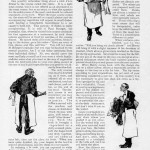 One of my favorite old articles I’ve come across so far has to be “How to Order in a Restaurant” from the February 1907 issue of the Delineator magazine. As if the charming illustrations of various well-dressed waiters weren’t enough, the article goes into fascinating detail about what it was like to go to a nice restaurant over 100 years ago.
One of my favorite old articles I’ve come across so far has to be “How to Order in a Restaurant” from the February 1907 issue of the Delineator magazine. As if the charming illustrations of various well-dressed waiters weren’t enough, the article goes into fascinating detail about what it was like to go to a nice restaurant over 100 years ago.
I am going to include the entire article at the end of this post, but first I will share with you some of what I consider the highlights.
The author of this article was named Elizabeth M. Rhodes, and as she writes she shares with the readers enough helpful tips to allow them to eat in a nice place without humiliating themselves.
“Probably we have all known embarrassment in a restaurant. There are any number of well-bred people, accustomed to the refinements of a home table, who have not dined in public often enough to know the correct order of procedure… Remembering with fatal vividness the embarrassment of my own ignorance as an inexperienced schoolgirl, I present these suggestions.”
So, here are her suggestions:
1. Unless your restaurant is a very cheap one, a waiter near the door will take you under his protection at once and lead the way to a table.
You may take any other table you like better that is not already engaged; but unless there is good reason, do not balk the waiter in his friendly desire to make you feel at home.
2. As soon as you are seated, the waiter will present the printed menu. If he fails to do so, ask him for it.
Menu, by the way, is properly accented on the second syllable, with the e of the first syllable short. But as nearly everyone in this country pronounces it incorrectly, you will be inconspicuous if you follow the fashion and say may-nu.
3. Perhaps the most confusing factor in giving an order is the difference between ordering a table d’hote dinner and ordering a la carte.
In ordering a la carte, that is, according to the card, or printed list, one has full and free choice of all dishes, from a ham sandwich to a formal course luncheon. The price of each article is printed on the card, and the total of the bill varies according to what you order.
A table d’hote dinner is a course dinner, with the dishes assigned by the restaurant… The table d’hote list is often printed, too; but you can distinguish it because the a la carte list has the price given after each dish, while the table d’hote list has it above.
4. When you have finished, say to the waiter, “Will you bring my check, please?”
…and Henry [the waiter] will bring it with a slight increase in his devotion of manner, which always grows more marked as the time for the tip approaches. Give him the money for the bill. Do not pay at the desk on the way out, except at a low-priced restaurant where the busy waitress punches a printed check for you and passes on to the next customer.
5. When Henry comes back, with the change due you on a silver salver, return a reasonable amount of change to the tray as a tip.
The tip varies according to your expenditure, ten percent of your bill being considered a fair fee. In this country it is not customary to give less than ten cents as a tip. Don’t grudge the tip, and don’t withhold it. Count in your tip as a legitimate part of the dinner expenses; and if you resent the tipping custom, write to the papers about it, or patronize the pay-at-the-desk restaurant, but don’t take it out on the waiter.
6. Leave your napkin unfolded on the table; leave your chair where you pushed it as you arose.
Let the waiter help you with your coat and hand you your furs. He takes pride in doing the correct thing and earning his tip. And don’t, pray, help yourself to a toothpick at the table and use it as you leave the place.
If you would like to read the entire article, which also includes more details on what food was typically offered and how it was served, just click on the thumbnails below.
Ms. Rhodes leaves her readers with one final thought, meant to put their mind at ease if they do make some blunders during their dinner out:
“You may have shown more of homespun and less of social experience than your restaurant neighbors; but, after all, you can probably give them points on something much more important than the proper way of ordering a dinner.”







{ 0 comments… add one }